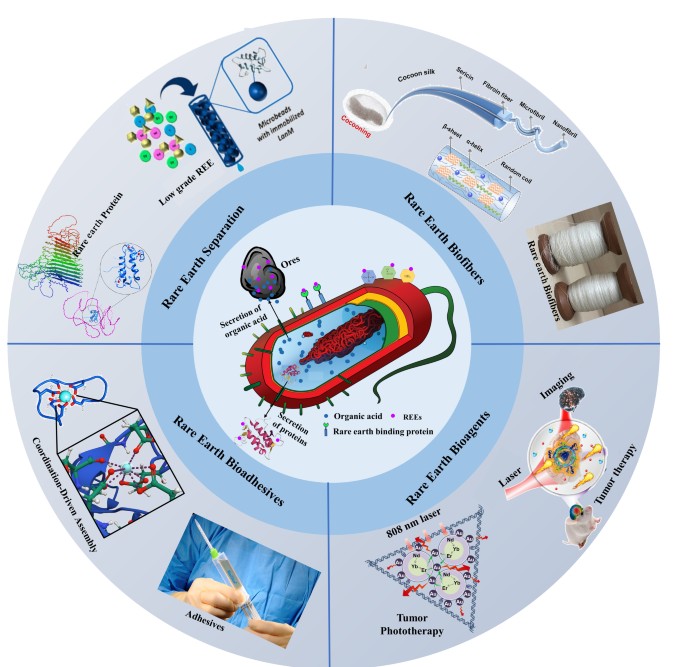Hightlights
- Synthetic biology offers sustainable methods for rare earth element extraction.
- Genetically engineered microbes can improve resource efficiency.
- Challenges include scalability and competition with traditional methods.
Essential rare earth elements (REEs), essential raw materials vital for the advancement of modern high-tech industries, pose extraordinary challenges when it comes to extraction often leading to environmental concerns, domination of some nations over others, and costly economic processes. Also, chemical properties of REEs contribute to both high energy usage and marked pollution emissions involving the separation process. Addressing such challenges while promoting sustainable development and efficient resource utilization, some scientists look to synthetic biology techniques, part of a movement to engineer microorganisms for rare earth fabrication.
So, what would it take to establish an engineered microorganism manufacturing platform? A platform allowing in-situ synthesis of high-value rare earth biomaterials?
Such innovations both help clinical translational research while enhancing applications in novel fields. This article offers a comprehensive review of the rational construction of rare earth cell factories, the synthesis of high-value rare earth biomaterials, and their diverse applications in high-tech industries. Moreover, it examines the perspectives and challenges within the domain of lanthanide materials fabrication using microbial systems.
Huijing Cui, a PhD (opens in a new tab) student, Professor Kai Liu (opens in a new tab), both at Tsinghua University (opens in a new tab), Beijing and colleagues at the Engineering Research Center of Advanced Rare Earth Materials and the Changchun Institute of Applied Chemistry (opens in a new tab), Chinese Academy of Sciences write up a survey of this fascinating nascent field.
Source: Science China Materials
Advancements in synthetic biology are opening new possibilities for the sustainable production and extraction of REEs, which are critical for industries like renewable energy, electric vehicles, and electronics.
Traditionally, REEs are extracted through environmentally damaging mining processes, but synthetic biology techniques are offering innovative, more sustainable alternatives.
Rare Earth Exchanges reviewed the recent Chinese article published in Science China Materials and summarizes some basic trends below.
Biomining is a nascent example, the use of microorganisms (like bacteria or fungi) to extract rare earth elements from ores or industrial waste. These microbes are engineered to break down mineral ores or to leach metals from materials by producing organic acids or other biochemicals.
In this realm of activity acidophilic bacteria are particularly effective at leaching metals from low-grade ores or mining waste that would otherwise be considered economically unviable. This technique reduces the environmental impact of traditional mining by minimizing the need for harmful chemicals and energy-intensive processes.
What about genetically engineered microorganisms?
Scientists are using genetic engineering to create microbes specifically designed to capture, bind, and concentrate rare earth elements. For example, certain bacteria are engineered to produce proteins or peptides that can selectively bind to rare earth elements in complex mixtures.
Researchers at institutions like Lawrence Berkeley National Laboratory (opens in a new tab) have identified proteins in microbes that naturally interact with rare earths. By genetically modifying these microbes, they enhance their ability to capture REEs from low-concentration sources, such as mine tailings or even electronic waste.
Can biomaterials be used for cleaner separation?
Possibly. Advances in synthetic biology allow for the design of bio-based materials (such as biofilms or engineered proteins) that have the potential to selectively bind and separate rare earth elements. These materials are designed to mimic the way some natural organisms sequester metals.
Synthetic biologists have engineered proteins or peptides to have high affinities for specific REEs. This makes it possible to selectively capture and separate individual rare earth elements from a mixture, which is one of the key challenges in rare earth processing.
Another mechanism is known as microbial biosorption. This involves using the cell walls of microorganisms, particularly fungi or algae, to bind and accumulate rare earth elements from aqueous solutions. These microbes can be engineered to enhance their metal-binding capabilities.
This process is particularly promising for recovering rare earth elements from industrial effluents, water sources contaminated by mining operations, or even from e-waste recycling processes. The key advantage is that biosorption can be done at room temperature and pressure, making it energy-efficient and environmentally friendly.
What about biomineralization?
This describes the process by which living organisms naturally form minerals. In synthetic biology, scientists are engineering microorganisms to form minerals containing rare earth elements, which can then be extracted in a controlled manner.
This can be thought of as a form of REE harvesting. By tweaking the metabolic pathways of these organisms, researchers can direct them to selectively precipitate rare earth elements from complex solutions, providing a biogenic method for extracting and purifying these valuable materials.
A range of other scientific advancements exist from synthetic biology for recycling e-Waste and biomass utilization to modular biocatalytic systems.
What are the possible benefits of these contemplated advancements?
A range of benefits are anticipated from environmental sustainability meaning the involvement of fewer toxic chemicals and less waste than conventional mining and extraction methods, to cost reduction based on use of bio-based processing to improved supply chain security.
But there must be challenges?
Absolutely. From efforts to scale-up synthetic biology manufacturing from a lab environment to industrial scalability remains a reality not today, but some time in the future.
Also achieving the desired selectivity and efficiency for specific rare earth elements remains difficult, especially in complex mixtures or low concentrations. Finally, the scaling out of biotechnological solutions must also navigate regulatory hurdles and compete with well-established mining industries, which can slow adoption.
Some Final Thoughts
Professor Liu and his co-authors raise important points concerning synthetic biology, a good summary of the emerging, transformative approach to producing and recovering rare earth elements in a more sustainable, cost-effective, and environmentally friendly manner.
These advancements could reduce the environmental impact of rare earth mining and help address global supply chain challenges, especially as demand for rare earths continues to grow in key industries like renewable energy and electric vehicles.


Daniel
You Might Also Like…